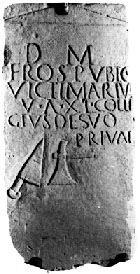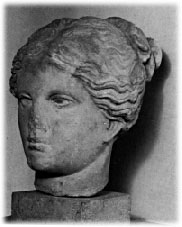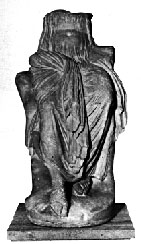Epigraphic Section (1st room)
The epigraphic collection is the most important part of the Civic Collection.
Arranged according to updated exposition criteria, it includes mainly slabs and stelae, some altars, few aedicule, two milestones, all coming mostly from Brindisi’s necropolis, located along the Appian road and the Appian-Trajan road, and only exceptionally they have their original archaeological contexts. |
|
|
Epigraph decorated with tools in memory of the dead’s profession
|
|
 Chronologically, the epigraphs date back to a period that goes from the Ist century B.C. up to the IIIrd-IVth centuries A.C. They are mostly written in latin, ten in greek and three in hebrew; the praiseworthy among these last is the stele in which the dedicator whishes a young woman named Lea, that the Eden’s gardens would be opened to her. Chronologically, the epigraphs date back to a period that goes from the Ist century B.C. up to the IIIrd-IVth centuries A.C. They are mostly written in latin, ten in greek and three in hebrew; the praiseworthy among these last is the stele in which the dedicator whishes a young woman named Lea, that the Eden’s gardens would be opened to her.
As far as the epigraphs written in latin are concerned, the largest collection is composed of funerary inscriptions, stelae, aedicule and altars.
The main elements composing the funerary inscriptions are the initial formula DM (Dis Manibus — to Manes’Gods), that’s a dedication to the Gods protecting the tomb; the name of the dead as well as his/her age follows; sometimes even their political and military charges or the profession practiced when alive are mentioned, but more frequently it was the relationship between the dead and the dedicator.
A statistics about mortality shows that, as far as men are concerned, the life limit is around 30 and 40 years, except for the few cases of senile death, with a high rate of children’s death, while for women it is between 18 and 25 years.
Often the epigraphs show, together with the written parts, ingraving and carving decorative pictures: small palms, small roses, lieves motives; but also apotropaical pictures: a fish or a hand ingraved on an altar exhibited in the Museum entrance-hall and objects of every day usage. Some tools are represented in memory of the profession practiced by the dead.
Statues' Section (1st room)
The statues’ collection gathers statues and portraits mostly recovered during the excavations made in Brindisi and in the surrounding territory, between the end of the last century and the beginning of this last; generally they are minor funerary and decorative works, these last are sometimes copies of the famous originals ascribed in a chronological period rather wide, coinciding with the Ist century B.C. and the IInd century A.C. Probably, the development of art in Brindisi’s province took place at the same time as that of Rome and this was possible for the two centres were connected to eachother by means of the Appian Road. When Rome lost its empire, Brindisi also was condamned to a process of irretrievable decline, both commercial and artistical.
However, the remaining works show the handicraft characteristics of the production. To be noticed, in some portraits, the interest in representing the expressive grace and the face features. In its whole, the statues’collection has its own original characteristics.
Brindisi was influenced by Greece after becoming a latin colony in the 244 B.C., rich in shipyards, commerce, fervent economical activities and exchanges with the East. |
|
|
 Contacts with Hellenism were particular and very intense. The presence of the hellenic civilization in Brindisi is proved,as far as the sculptures are concerned, by two portraits dating back to the Ist century B.C. and the Ist century A.C., and by two statues probably representing Nymphs or a dressed Aphrodite. Contacts with Hellenism were particular and very intense. The presence of the hellenic civilization in Brindisi is proved,as far as the sculptures are concerned, by two portraits dating back to the Ist century B.C. and the Ist century A.C., and by two statues probably representing Nymphs or a dressed Aphrodite.
Noteworthy is the feminine acephalous statue, dressed with chiton and himation, dating back to the end of the IInd century B.C. |
|
|
Feminine statue representing a Ninph or Aphrodite
|
|
 The statue of a woman dating back to the Ist century A.C. reminds of the funerary culture, probably a roman copy of a greek original work belonging to the art’s tradition of the IVth century B.C., the period during which this kind of funerary sculpture is produced. The statue of a woman dating back to the Ist century A.C. reminds of the funerary culture, probably a roman copy of a greek original work belonging to the art’s tradition of the IVth century B.C., the period during which this kind of funerary sculpture is produced. |
|